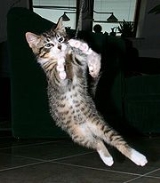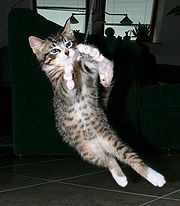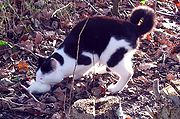
Cat play and toys
Encyclopedia

Cat
The cat , also known as the domestic cat or housecat to distinguish it from other felids and felines, is a small, usually furry, domesticated, carnivorous mammal that is valued by humans for its companionship and for its ability to hunt vermin and household pests...
play and toys incorporates predatory games of "play aggression". These activities allow kittens and younger cats to grow and acquire cognitive and motor skills, and to socialize with other cats. Cat play behavior can be either solitary (with toys or other objects) or social (with animals and people).
Predation

Predation
In ecology, predation describes a biological interaction where a predator feeds on its prey . Predators may or may not kill their prey prior to feeding on them, but the act of predation always results in the death of its prey and the eventual absorption of the prey's tissue through consumption...
s, nearly all cat games are predatory games.
Prey
Predation
In ecology, predation describes a biological interaction where a predator feeds on its prey . Predators may or may not kill their prey prior to feeding on them, but the act of predation always results in the death of its prey and the eventual absorption of the prey's tissue through consumption...
is fearful of predators. Predators often encounter prey that attempt to escape predation. Prey that moves towards the cat with confidence may be exhibiting an aggressive defensive posture. Cats often play with toy
Toy
A toy is any object that can be used for play. Toys are associated commonly with children and pets. Playing with toys is often thought to be an enjoyable means of training the young for life in human society. Different materials are used to make toys enjoyable and cuddly to both young and old...
s that behave more like fearful prey trying to escape than toys that mimic a more confrontational prey.
Most cat games mimic a specific type of hunting;such as mice or people :) for example, ball
Ball
A ball is a round, usually spherical but sometimes ovoid, object with various uses. It is used in ball games, where the play of the game follows the state of the ball as it is hit, kicked or thrown by players. Balls can also be used for simpler activities, such as catch, marbles and juggling...
s, finger
Finger
A finger is a limb of the human body and a type of digit, an organ of manipulation and sensation found in the hands of humans and other primates....
s, sticks, and laser pointer
Laser pointer
A laser pointer or laser pen is a small portable device with a power source and a laser emitting a very narrow coherent low-powered beam of visible light, intended to be used to highlight something of interest by illuminating it with a small bright spot of colored light...
s emulate insects, while rope
Rope
A rope is a length of fibres, twisted or braided together to improve strength for pulling and connecting. It has tensile strength but is too flexible to provide compressive strength...
or string
Twine
Twine is a light string or strong thread composed of two or more smaller strands or yarns twisted together. More generally, the term can be applied to any thin cord....
may emulate a snake.
Success rate
Success rate is important in play. A cat that catches its prey every time soon gets bored, and a cat that never gets it just loses interest. The ideal hunting success rate is around 1 in 3 to 1 in 6. Capturing prey at this rate generally maximises a cat's interest in the game.Precautions
Play is about predation, and a highly excited cat can cause minor injuries in the excitement of the moment. With most cats, it is wise to keep playthings at least 20 cm (8") away from fingers or eyes, and avoid encouraging a cat to eat inedible toys. If playing with the bare hands, a cat will generally resist using its claws or biting too hard, but a cat that becomes extremely excited may accidentally inflict injuries to its human playmate in the form of light scratches or small puncture wounds from biting too hard. Cats claws and mouth can contain bacteria that can lead to infection, so it is wise to clean and treat any wounds with an antiseptic solution and seek professional medical services if there is belief that the wound has become infected.Food
Catching and eatingEating
Eating is the ingestion of food to provide for all organisms their nutritional needs, particularly for energy and growth. Animals and other heterotrophs must eat in order to survive: carnivores eat other animals, herbivores eat plants, omnivores consume a mixture of both plant and animal matter,...
are two closely related but separate activities. Domestic cats often store caught food
Food
Food is any substance consumed to provide nutritional support for the body. It is usually of plant or animal origin, and contains essential nutrients, such as carbohydrates, fats, proteins, vitamins, or minerals...
for eating later. Eating happens when the game is over, so incorporating food into hunting games tends to end the interest in play.
Further reading
.. – Scholar search|archiveurl = http://web.archive.org/web/20071213055244/http://www.aspca.org/site/PageServer?pagename=pets_playaggression |archivedate = 2007-12-13}}. – Scholar search
|archiveurl = http://web.archive.org/web/20071229232452/http://www.aspca.org/site/PageServer?pagename=pets_catsplay |archivedate = 2007-12-29}}.

